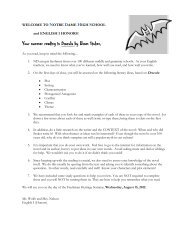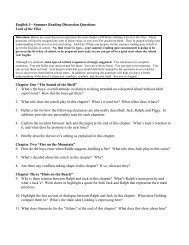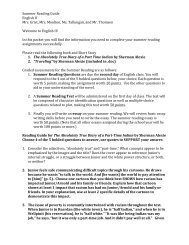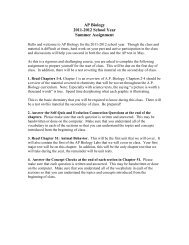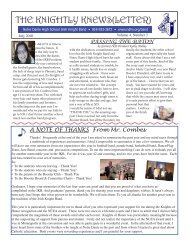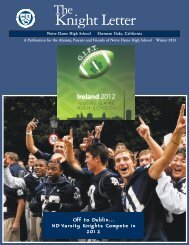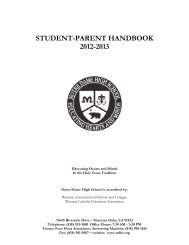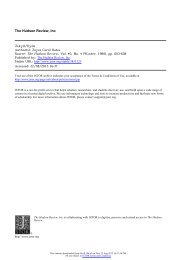Create successful ePaper yourself
Turn your PDF publications into a flip-book with our unique Google optimized e-Paper software.
4/25/13 Bloom's Literary Reference Online - Print PageClose Window<strong>Yeats</strong>, William ButlerBorn: 1865 Died: 1939Irish poet, playwrightFrom: William Butler <strong>Yeats</strong>, Bloom's Major Poets.Though it is generally accepted that W. B. <strong>Yeats</strong> confided almosteverything about his life and his experience in his manuscripts, diaries, andintroductions to his works, the more we read about him, the more elusivehe becomes. We cannot wholly trust his voluminous autobiographicalwritings, later collected in his Autobiography, because <strong>Yeats</strong> constantlyconstructed myths about himself. Although he spent much of his timetrying to understand the contradictions in his mind, he rarely laid thembare. <strong>Yeats</strong>'s obsessions with complex, esoteric philosophies that includedmagic, occultism, and mysticism, coupled with his strong Irish nationalism,make it difficult to construct a portrait of the poet.William Butler <strong>Yeats</strong> was born in Sandynont, Dublin, on June 13, 1865. Onhis father's side his ancestry can be traced back well into the 18th century, showing a line ofland-owning prosperity. His mother came from a prosperous merchant family, the Pollexfens, inSligo, Ireland. When <strong>Yeats</strong> was two years old, his father, John Butler <strong>Yeats</strong>, abandoned thedistinguished profession of barrister and moved his family to London so he could study painting.He also gave up his family's Christian faith (both his great-grandfather and his grandfather wereparsons). John had been under the influence of the rationalism of John Stuart Mill and AugusteComte, but after he went to London he spoke more often of William Blake and Walt Whitman, andhe introduced his son to their poetry.Because of financial difficulties, the <strong>Yeats</strong> moved back to Dublin in 1880, where W. B. <strong>Yeats</strong>attended high school. In 1883, he went to the Metropolitan School of Art in Dublin. He spent hisholidays in Sligo, the setting of many of his poems.<strong>Yeats</strong>'s first publication, two short lyrics, appeared in the Dublin University Review in 1885. Inthe same year, he devoted himself to forming an occult group, the Dublin Hermetic Society.<strong>Yeats</strong> joined another group, the Theosophical Society, when he and his family went back toLondon in 1887, a year after he quit his art studies to pursue a writing career. <strong>Yeats</strong> didn't likethe Age of Science and was far more interested in the mysticism of astrology than theconcreteness of astronomy; it seems quite natural that the Theosophical Society, a growinginternational movement that sought wisdom through mysticism, fascinated him.The year 1889 was a watershed for <strong>Yeats</strong>. His early poems, collected in The Wanderings of Oisinand Other Poems, were published and very favorably received. Oscar Wilde was one of thereviewers who praised the volume. In addition, <strong>Yeats</strong> made the acquaintance of poet WilliamMorris, whose influence he acknowledged throughout his career. Also, that same year <strong>Yeats</strong> metMaud Gonne, with whom he fell deeply in love. Unfortunately, his sentiments were not returned;that was when, as he himself remarked later, "the troubling of [my] life began." <strong>Yeats</strong> soonbecame involved in the Irish nationalist cause, partly because it was Maud Gonne's chief passion.The young poet felt that Irish political life could achieve more significance if filled with art,poetry, drama, and legend.By the 1890s, <strong>Yeats</strong> was already something of a celebrity in the London literary and artisticscene. In 1891, he founded "The Rhymers Club," one of the most well-known groups of fin-desièclepoets; among its members were poets whom <strong>Yeats</strong> later called "the tragic generation":Lionel Johnson, Ernest Dowson, John Davidson, and Arthur Symmons. He made several trips towww.fofweb.com/Lit/MainDetailPrint.asp?iPin=BMPWBY02&WinType=Free 1/3
4/25/13 Bloom's Literary Reference Online - Print PageParis, becoming familiar with modern French poetry; on one trip, he met the French poet PaulVerlaine, whom he admired. Throughout Paris, the belief in "art for art's sake" (l'art pour l'art)was at its height. An additional important influence of this period was <strong>Yeats</strong>'s intensive study ofBlake's poems, which he undertook in collaboration with Edwin Ellis. This led to an edition ofBlake's poetry in 1893. The Wind among the Reeds, <strong>Yeats</strong>'s next volume of poetry, came out in1899.In 1896 <strong>Yeats</strong> met an ally in the Irish nationalist cause, Augusta Lady Gregory, an aristocrat whocollected old stories, the lore of west Ireland. Her friendship sustained him until her death in1932. From 1897 on, <strong>Yeats</strong> spent his summers at Coole Park, Lady Gregory's home. <strong>Yeats</strong>believed that literature could help engender a national unity that would be capable oftransfiguring the Irish nation. With Lady Gregory's help, <strong>Yeats</strong> established an Irish nationaltheater. This ultimately led to the founding of the famous Abbey Theater in Dublin. <strong>Yeats</strong> wrotethe play On Baile's Strand for the theater's opening night in 1904, and he devoted himself to thedaily tasks of running the Abbey for several years afterward.Between 1902 and 1908, presumably because of his involvement with theater life, <strong>Yeats</strong> wroteonly a few lyrics. He also began a process of "remaking" himself, a modification rather than a neworientation, that would possess him for the next 37 years. (In his seventies he wrote a marvelouslyric on this theme, "Myself must I remake.")He traveled to Italy with Lady Gregory in 1907, visiting Florence, Milan, Urbino, and Ravenna. Hisyearning for Renaissance Italy reverberated throughout his work of this period. In 1913, <strong>Yeats</strong>engaged Ezra Pound as his secretary, and the two poets would significantly influence each other.The following year, <strong>Yeats</strong> published another volume of poems, Responsibilities, which containspoems written over a long period of time, 1907–1914.Gradually, <strong>Yeats</strong> noticed that the Abbey Theater seemed to be losing its soul, since many of theplays struck <strong>Yeats</strong> as being vulgar. Soon he would encounter a new kind of drama. In the winterof 1915, Pound was translating Japanese Nô plays. <strong>Yeats</strong> found them to be a perfect blend ofwords, masks, dance, and music. He wrote several plays, including At the Hawk's Well (1916), inthe style of Nô drama.After being rejected several times by Maud Gonne, who eventually married a "man of action" (anIrish soldier, Major John MacBride), <strong>Yeats</strong> wedded Miss Georgie Hyde-Lees in 1917. The WildSwans at Coole, another volume of poetry, was published that year. The couple's daughter, AnnButler <strong>Yeats</strong>, was born in 1919, and a son, William Michael <strong>Yeats</strong>, in 1921.In the 1920s, <strong>Yeats</strong> achieved political as well as literary success. In 1922, when the Irish FreeState was established, he became a senator. Already a very esteemed international literaryfigure, he was awarded the Nobel Prize for Literature in 1923 (which he did not decline, as hehad an offer of knighthood in 1915). Two years later, <strong>Yeats</strong> presented his meditation upon therelationship between imagination and the occult in the prose work A Vision, which was firstpublished in 1925 and revised into its final form in 1937. Much of the symbolism of <strong>Yeats</strong>'s laterpoetry would rely on the historical and philosophical system that the poet explicated in A Vision.The Tower (1928), one of <strong>Yeats</strong>'s strongest collections of poems, named after a ruined Normancastle he bought at Gort, was enthusiastically received by the critics and sold very well. As earlyas 1900, writing of Shelley's use of the tower symbol, <strong>Yeats</strong> saw the tower as a symbol of "amind looking inward upon himself."<strong>Yeats</strong> continued writing through his sixties with a persistent intensity of feelings. With hisleanings towards authoritarian ideology, it has often been charged that he was a Fascist duringhis last years. (It is true that he admired Italian Fascist dictator Benito Mussolini for his vigor.)The Winding Stair and Other Poems appeared in 1933. In the five years that followed, after theoften-ill poet underwent a Steinach rejuvenation operation in 1934, <strong>Yeats</strong> produced four versewww.fofweb.com/Lit/MainDetailPrint.asp?iPin=BMPWBY02&WinType=Free 2/3
4/25/13 Bloom's Literary Reference Online - Print Pageplays; the poetry collection A Full Moon in March (1935); an edition of the Oxford Book ofModern English Verse 1892–1935 (1936); and the final revision of A Vision. His Last Poems werepublished posthumously, after he died in southern France in 1939. Final arrangements for hisburial in Ireland couldn't be made until 1948, after World War II, when his body was finally takento Sligo.<strong>Yeats</strong> devoted much of his work to the exploration of the sometimes heartbreaking contradictionsbetween life and death, creating a brave acceptance of the whole spectrum of humanexperience. His own epitaph, addressing those subjects, was engraved on his tomb:Cast a cold eyeOn life, on death.Horseman, pass by!Citation InformationImage Citation (Chicago Manual of Style format): "<strong>Yeats</strong>, William Butler." Library of Congress. Prints andPhotographs Division. Arnold Genthe Collection. Bloom's Literary Reference Online. Facts On File, Inc.http://www.fofweb.com/activelink2.asp?ItemID=WE54&SID=&iPin=BMPWBY02&SingleRecord=True (accessedApril 25, 2013).Text Citation (Chicago Manual of Style format): Bloom, Harold, ed. "<strong>Yeats</strong>, William Butler." William Butler<strong>Yeats</strong>, Bloom's Major Poets. Philadelphia: Chelsea House Publishing, 2001. Bloom's Literary Reference Online.Facts On File, Inc. http://www.fofweb.com/activelink2.asp?ItemID=WE54&SID=&iPin=BMPWBY02&SingleRecord=True (accessed April 25, 2013).Other Citation InformationModern Language Association (MLA) FormatAmerican Psychological Association (APA) FormatAdditional Citation InformationRecord URL:http://www.fofweb.com/activelink2.asp?ItemID=WE54&SID=&iPin=BMPWBY02&SingleRecord=True.www.fofweb.com/Lit/MainDetailPrint.asp?iPin=BMPWBY02&WinType=Free 3/3



